A Comprehensive Analysis of Nestle MILO's Logistics and Supply Chain
VerifiedAdded on 2022/10/08
|9
|1761
|28
Report
AI Summary
This report examines the logistics and supply chain management of Nestle's MILO product. It begins with an overview of Nestle's business operations and a description of MILO's supply chain, including suppliers, production, warehousing, distribution, retailers, and customers. The report then details the flow of information within Nestle's supply chain, followed by an analysis of the logistics strategies, inventory management techniques, and supply chain analytics employed. Furthermore, it provides suggestions for improving Nestle's supply chain competitiveness, such as adopting the FIFO method and sustainable practices. The analysis concludes with a discussion of the challenges and opportunities within Nestle's supply chain, emphasizing the importance of continuous improvement and adaptation to maintain a competitive edge in the market.
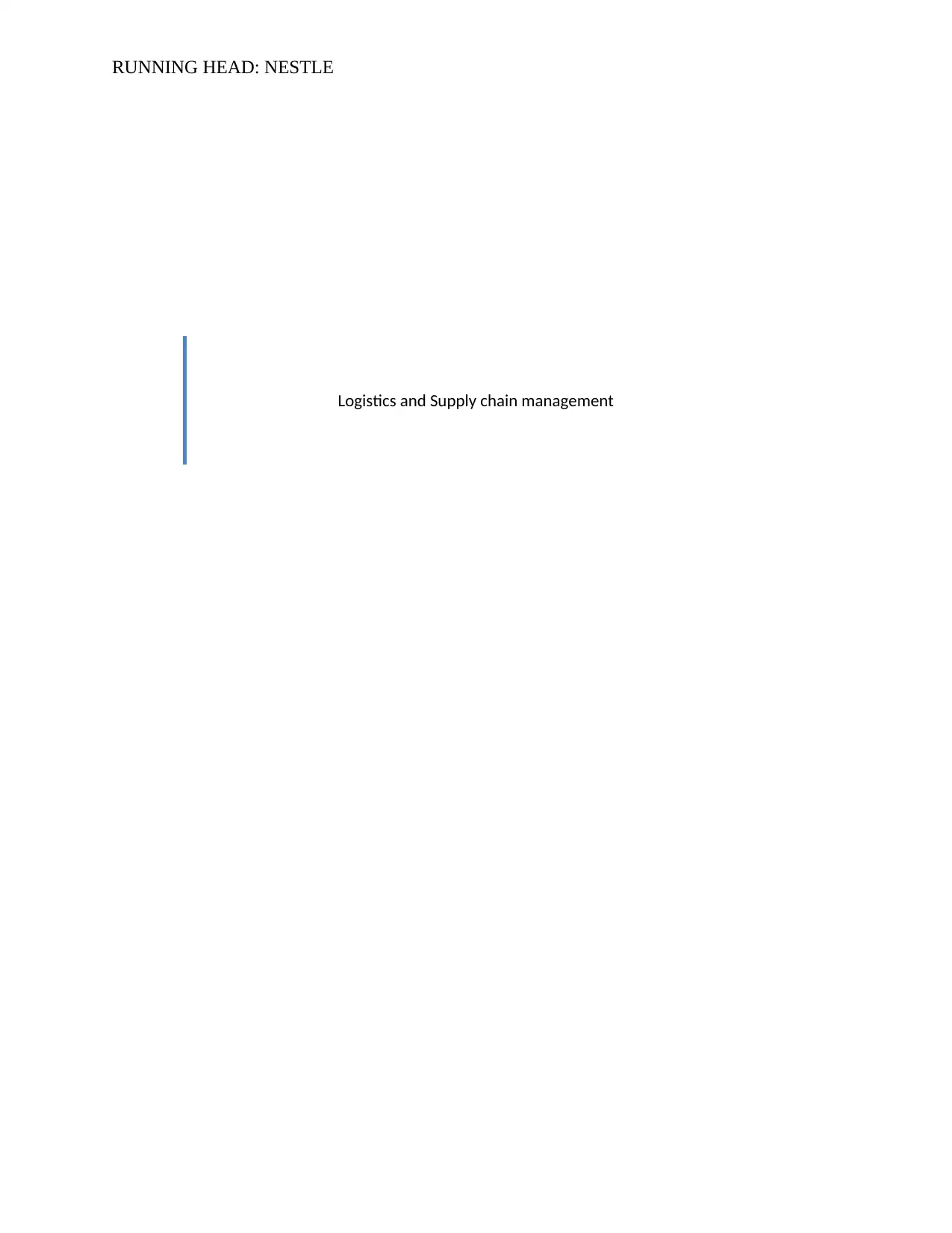
RUNNING HEAD: NESTLE
Logistics and Supply chain management
Logistics and Supply chain management
Paraphrase This Document
Need a fresh take? Get an instant paraphrase of this document with our AI Paraphraser
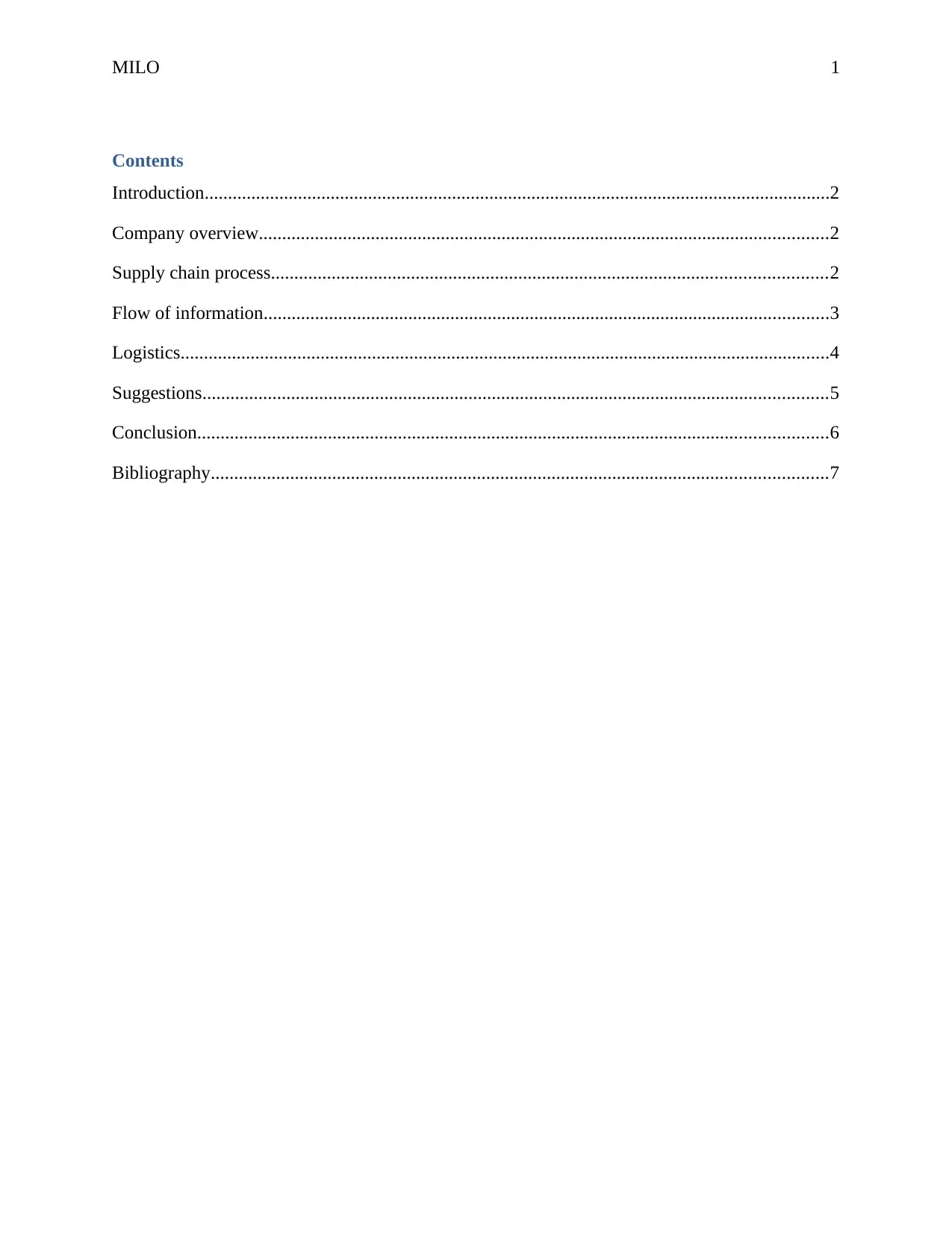
MILO 1
Contents
Introduction......................................................................................................................................2
Company overview..........................................................................................................................2
Supply chain process.......................................................................................................................2
Flow of information.........................................................................................................................3
Logistics...........................................................................................................................................4
Suggestions......................................................................................................................................5
Conclusion.......................................................................................................................................6
Bibliography....................................................................................................................................7
Contents
Introduction......................................................................................................................................2
Company overview..........................................................................................................................2
Supply chain process.......................................................................................................................2
Flow of information.........................................................................................................................3
Logistics...........................................................................................................................................4
Suggestions......................................................................................................................................5
Conclusion.......................................................................................................................................6
Bibliography....................................................................................................................................7
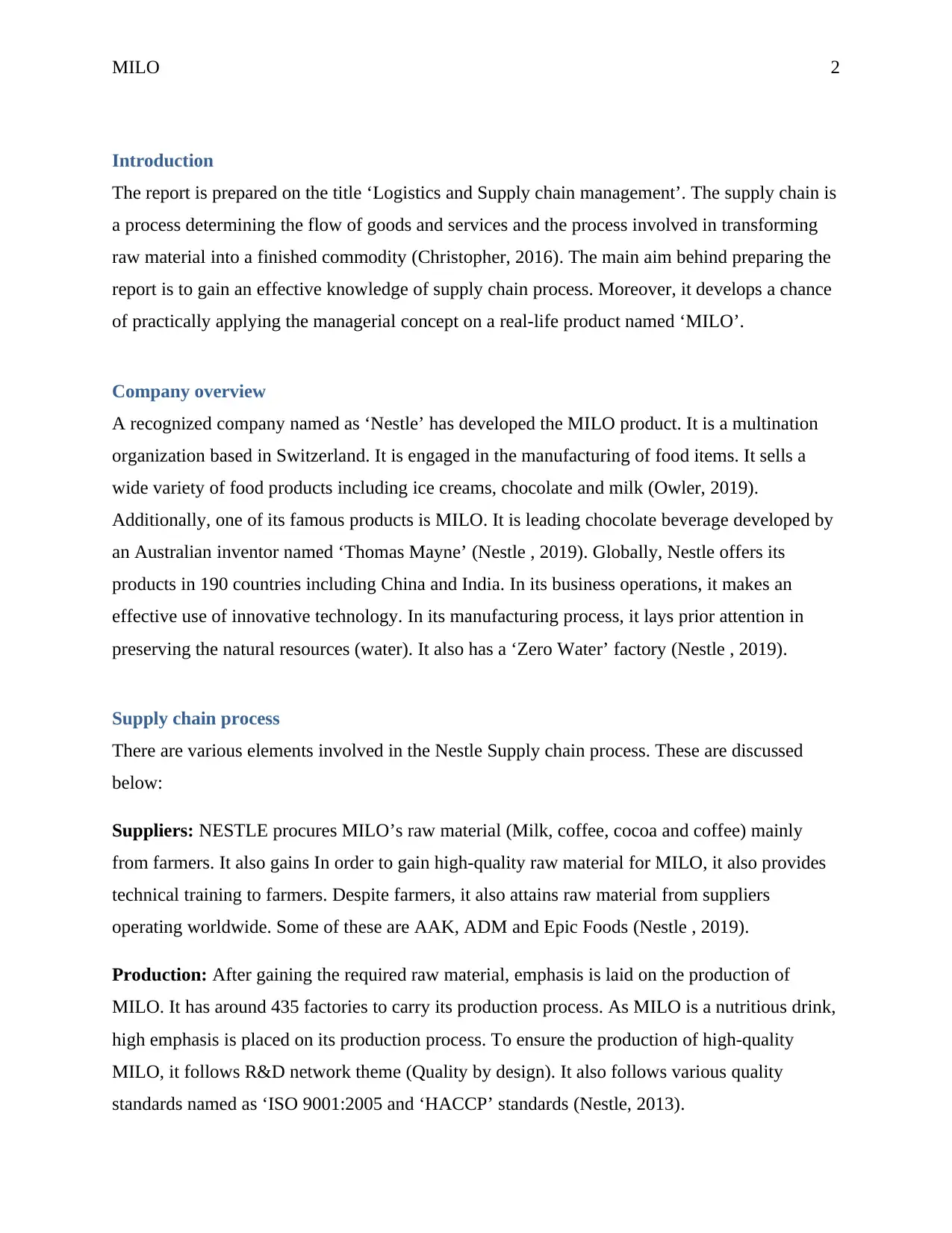
MILO 2
Introduction
The report is prepared on the title ‘Logistics and Supply chain management’. The supply chain is
a process determining the flow of goods and services and the process involved in transforming
raw material into a finished commodity (Christopher, 2016). The main aim behind preparing the
report is to gain an effective knowledge of supply chain process. Moreover, it develops a chance
of practically applying the managerial concept on a real-life product named ‘MILO’.
Company overview
A recognized company named as ‘Nestle’ has developed the MILO product. It is a multination
organization based in Switzerland. It is engaged in the manufacturing of food items. It sells a
wide variety of food products including ice creams, chocolate and milk (Owler, 2019).
Additionally, one of its famous products is MILO. It is leading chocolate beverage developed by
an Australian inventor named ‘Thomas Mayne’ (Nestle , 2019). Globally, Nestle offers its
products in 190 countries including China and India. In its business operations, it makes an
effective use of innovative technology. In its manufacturing process, it lays prior attention in
preserving the natural resources (water). It also has a ‘Zero Water’ factory (Nestle , 2019).
Supply chain process
There are various elements involved in the Nestle Supply chain process. These are discussed
below:
Suppliers: NESTLE procures MILO’s raw material (Milk, coffee, cocoa and coffee) mainly
from farmers. It also gains In order to gain high-quality raw material for MILO, it also provides
technical training to farmers. Despite farmers, it also attains raw material from suppliers
operating worldwide. Some of these are AAK, ADM and Epic Foods (Nestle , 2019).
Production: After gaining the required raw material, emphasis is laid on the production of
MILO. It has around 435 factories to carry its production process. As MILO is a nutritious drink,
high emphasis is placed on its production process. To ensure the production of high-quality
MILO, it follows R&D network theme (Quality by design). It also follows various quality
standards named as ‘ISO 9001:2005 and ‘HACCP’ standards (Nestle, 2013).
Introduction
The report is prepared on the title ‘Logistics and Supply chain management’. The supply chain is
a process determining the flow of goods and services and the process involved in transforming
raw material into a finished commodity (Christopher, 2016). The main aim behind preparing the
report is to gain an effective knowledge of supply chain process. Moreover, it develops a chance
of practically applying the managerial concept on a real-life product named ‘MILO’.
Company overview
A recognized company named as ‘Nestle’ has developed the MILO product. It is a multination
organization based in Switzerland. It is engaged in the manufacturing of food items. It sells a
wide variety of food products including ice creams, chocolate and milk (Owler, 2019).
Additionally, one of its famous products is MILO. It is leading chocolate beverage developed by
an Australian inventor named ‘Thomas Mayne’ (Nestle , 2019). Globally, Nestle offers its
products in 190 countries including China and India. In its business operations, it makes an
effective use of innovative technology. In its manufacturing process, it lays prior attention in
preserving the natural resources (water). It also has a ‘Zero Water’ factory (Nestle , 2019).
Supply chain process
There are various elements involved in the Nestle Supply chain process. These are discussed
below:
Suppliers: NESTLE procures MILO’s raw material (Milk, coffee, cocoa and coffee) mainly
from farmers. It also gains In order to gain high-quality raw material for MILO, it also provides
technical training to farmers. Despite farmers, it also attains raw material from suppliers
operating worldwide. Some of these are AAK, ADM and Epic Foods (Nestle , 2019).
Production: After gaining the required raw material, emphasis is laid on the production of
MILO. It has around 435 factories to carry its production process. As MILO is a nutritious drink,
high emphasis is placed on its production process. To ensure the production of high-quality
MILO, it follows R&D network theme (Quality by design). It also follows various quality
standards named as ‘ISO 9001:2005 and ‘HACCP’ standards (Nestle, 2013).
⊘ This is a preview!⊘
Do you want full access?
Subscribe today to unlock all pages.

Trusted by 1+ million students worldwide
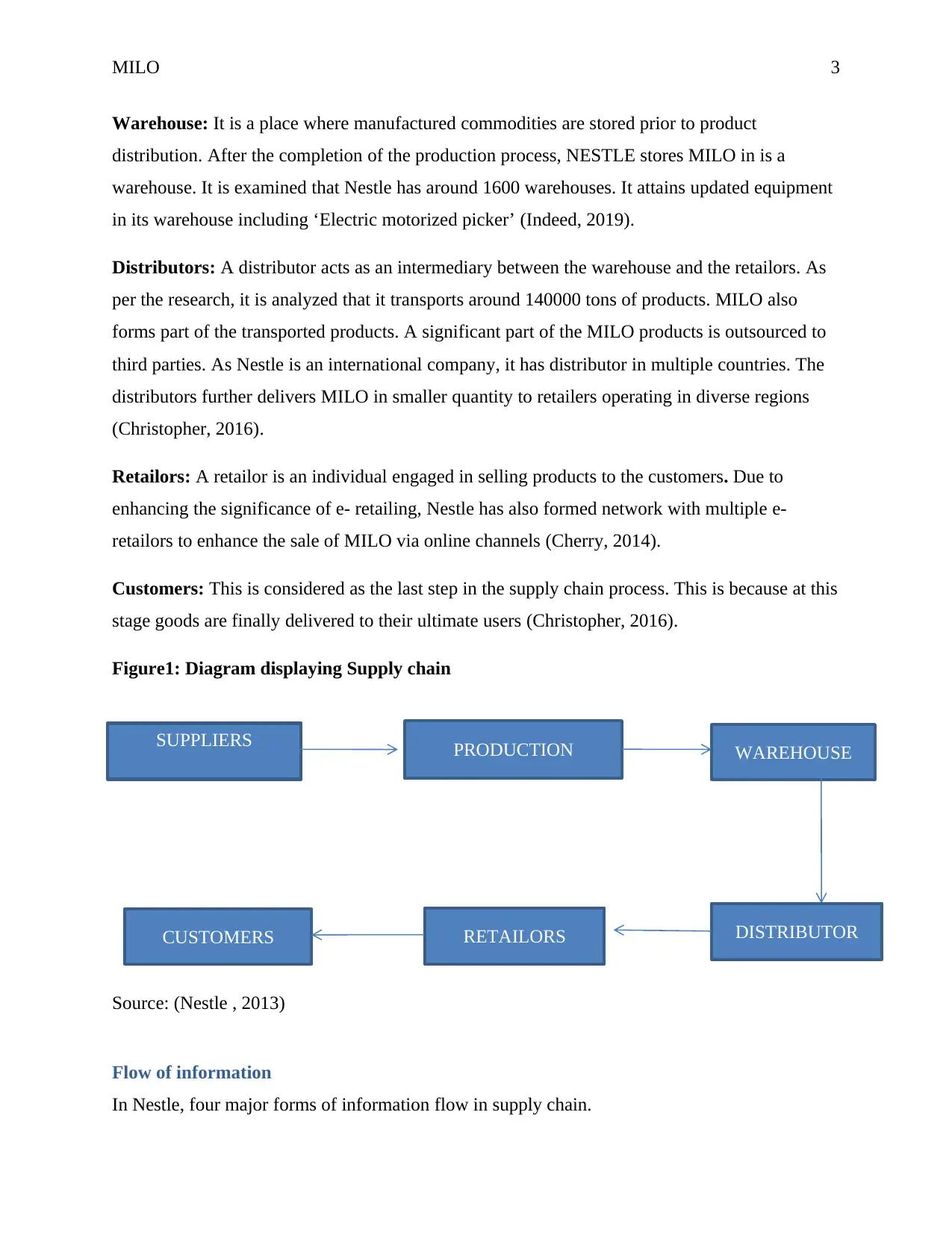
MILO 3
Warehouse: It is a place where manufactured commodities are stored prior to product
distribution. After the completion of the production process, NESTLE stores MILO in is a
warehouse. It is examined that Nestle has around 1600 warehouses. It attains updated equipment
in its warehouse including ‘Electric motorized picker’ (Indeed, 2019).
Distributors: A distributor acts as an intermediary between the warehouse and the retailors. As
per the research, it is analyzed that it transports around 140000 tons of products. MILO also
forms part of the transported products. A significant part of the MILO products is outsourced to
third parties. As Nestle is an international company, it has distributor in multiple countries. The
distributors further delivers MILO in smaller quantity to retailers operating in diverse regions
(Christopher, 2016).
Retailors: A retailor is an individual engaged in selling products to the customers. Due to
enhancing the significance of e- retailing, Nestle has also formed network with multiple e-
retailors to enhance the sale of MILO via online channels (Cherry, 2014).
Customers: This is considered as the last step in the supply chain process. This is because at this
stage goods are finally delivered to their ultimate users (Christopher, 2016).
Figure1: Diagram displaying Supply chain
Source: (Nestle , 2013)
Flow of information
In Nestle, four major forms of information flow in supply chain.
SUPPLIERS PRODUCTION
CUSTOMERS RETAILORS DISTRIBUTOR
WAREHOUSE
Warehouse: It is a place where manufactured commodities are stored prior to product
distribution. After the completion of the production process, NESTLE stores MILO in is a
warehouse. It is examined that Nestle has around 1600 warehouses. It attains updated equipment
in its warehouse including ‘Electric motorized picker’ (Indeed, 2019).
Distributors: A distributor acts as an intermediary between the warehouse and the retailors. As
per the research, it is analyzed that it transports around 140000 tons of products. MILO also
forms part of the transported products. A significant part of the MILO products is outsourced to
third parties. As Nestle is an international company, it has distributor in multiple countries. The
distributors further delivers MILO in smaller quantity to retailers operating in diverse regions
(Christopher, 2016).
Retailors: A retailor is an individual engaged in selling products to the customers. Due to
enhancing the significance of e- retailing, Nestle has also formed network with multiple e-
retailors to enhance the sale of MILO via online channels (Cherry, 2014).
Customers: This is considered as the last step in the supply chain process. This is because at this
stage goods are finally delivered to their ultimate users (Christopher, 2016).
Figure1: Diagram displaying Supply chain
Source: (Nestle , 2013)
Flow of information
In Nestle, four major forms of information flow in supply chain.
SUPPLIERS PRODUCTION
CUSTOMERS RETAILORS DISTRIBUTOR
WAREHOUSE
Paraphrase This Document
Need a fresh take? Get an instant paraphrase of this document with our AI Paraphraser
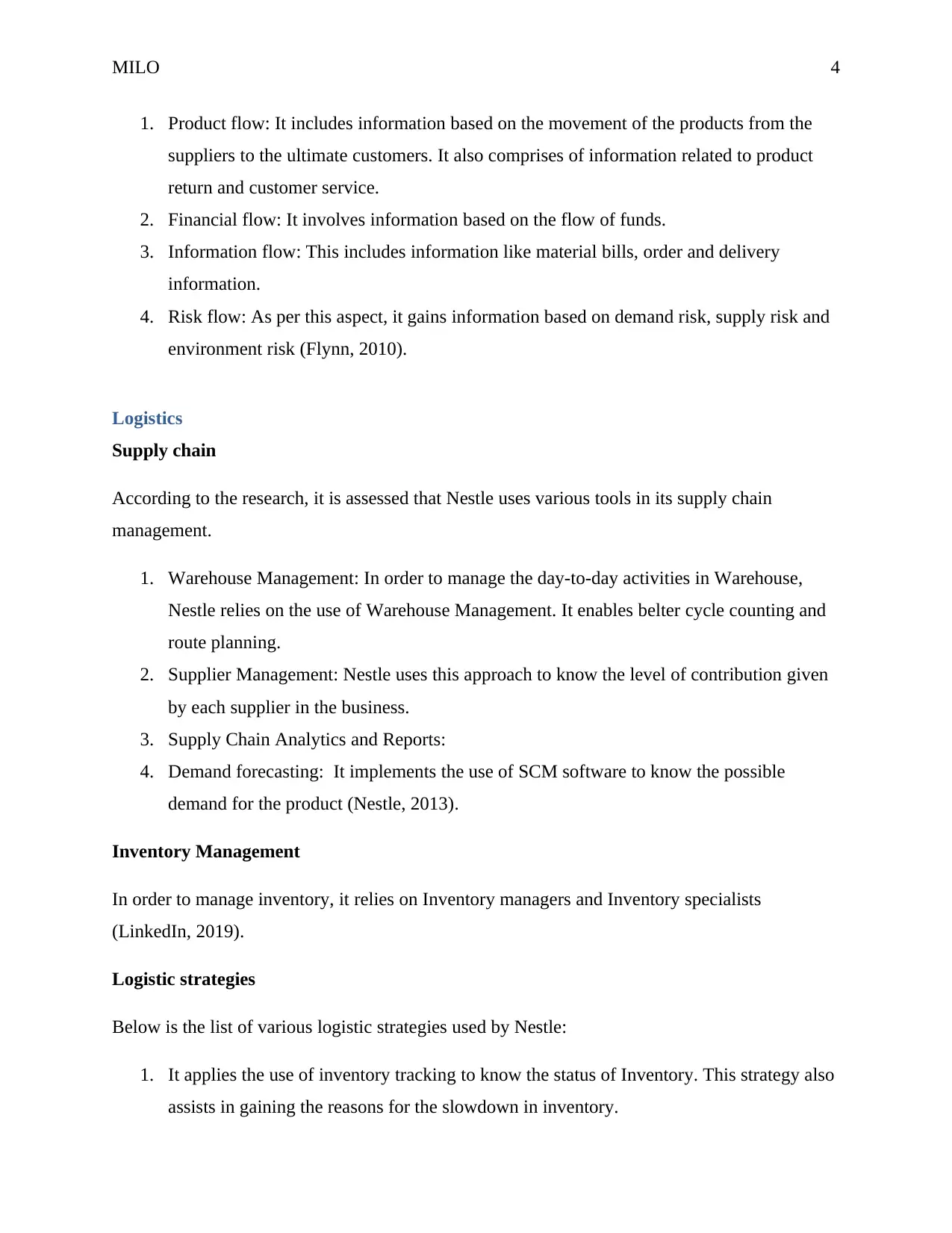
MILO 4
1. Product flow: It includes information based on the movement of the products from the
suppliers to the ultimate customers. It also comprises of information related to product
return and customer service.
2. Financial flow: It involves information based on the flow of funds.
3. Information flow: This includes information like material bills, order and delivery
information.
4. Risk flow: As per this aspect, it gains information based on demand risk, supply risk and
environment risk (Flynn, 2010).
Logistics
Supply chain
According to the research, it is assessed that Nestle uses various tools in its supply chain
management.
1. Warehouse Management: In order to manage the day-to-day activities in Warehouse,
Nestle relies on the use of Warehouse Management. It enables belter cycle counting and
route planning.
2. Supplier Management: Nestle uses this approach to know the level of contribution given
by each supplier in the business.
3. Supply Chain Analytics and Reports:
4. Demand forecasting: It implements the use of SCM software to know the possible
demand for the product (Nestle, 2013).
Inventory Management
In order to manage inventory, it relies on Inventory managers and Inventory specialists
(LinkedIn, 2019).
Logistic strategies
Below is the list of various logistic strategies used by Nestle:
1. It applies the use of inventory tracking to know the status of Inventory. This strategy also
assists in gaining the reasons for the slowdown in inventory.
1. Product flow: It includes information based on the movement of the products from the
suppliers to the ultimate customers. It also comprises of information related to product
return and customer service.
2. Financial flow: It involves information based on the flow of funds.
3. Information flow: This includes information like material bills, order and delivery
information.
4. Risk flow: As per this aspect, it gains information based on demand risk, supply risk and
environment risk (Flynn, 2010).
Logistics
Supply chain
According to the research, it is assessed that Nestle uses various tools in its supply chain
management.
1. Warehouse Management: In order to manage the day-to-day activities in Warehouse,
Nestle relies on the use of Warehouse Management. It enables belter cycle counting and
route planning.
2. Supplier Management: Nestle uses this approach to know the level of contribution given
by each supplier in the business.
3. Supply Chain Analytics and Reports:
4. Demand forecasting: It implements the use of SCM software to know the possible
demand for the product (Nestle, 2013).
Inventory Management
In order to manage inventory, it relies on Inventory managers and Inventory specialists
(LinkedIn, 2019).
Logistic strategies
Below is the list of various logistic strategies used by Nestle:
1. It applies the use of inventory tracking to know the status of Inventory. This strategy also
assists in gaining the reasons for the slowdown in inventory.
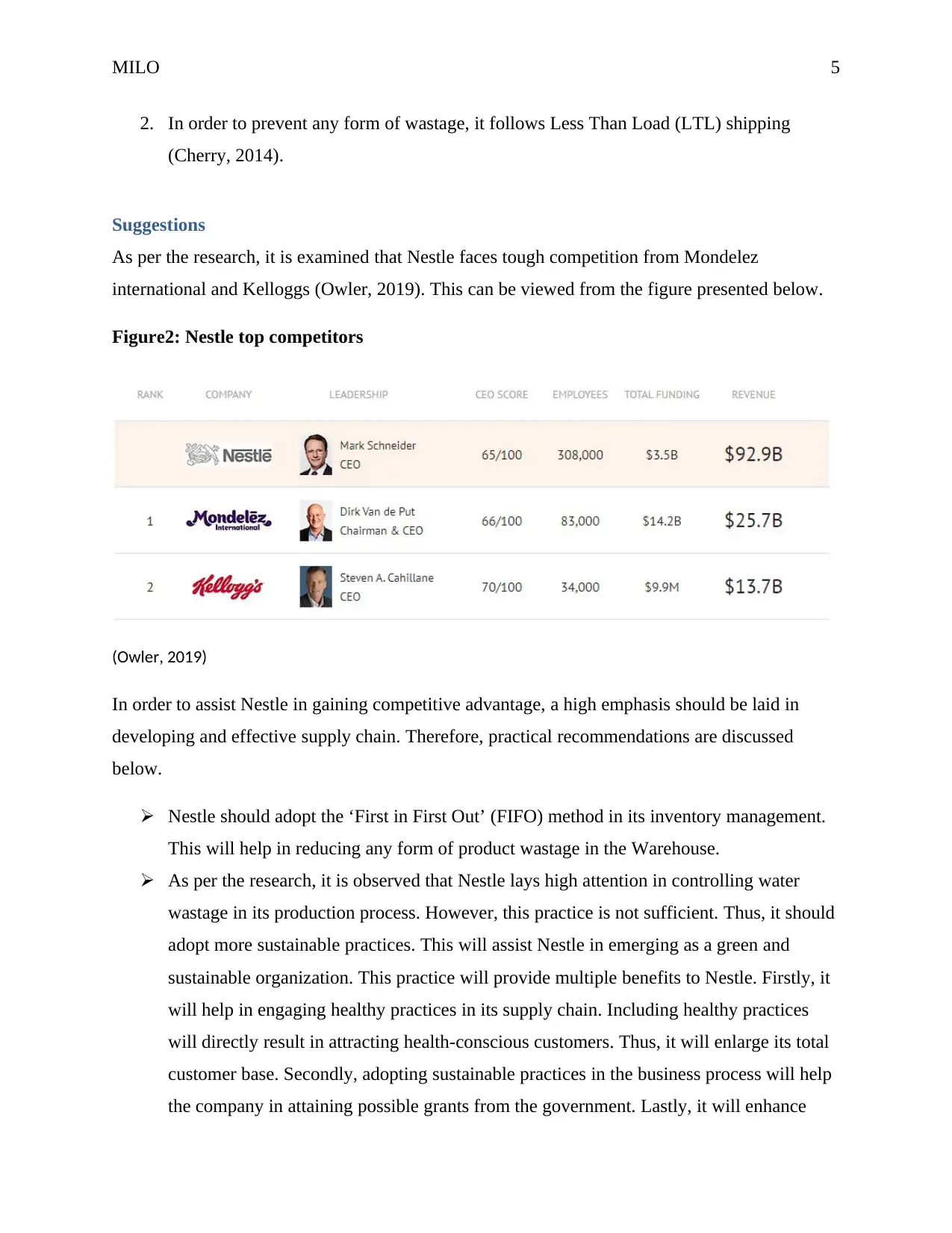
MILO 5
2. In order to prevent any form of wastage, it follows Less Than Load (LTL) shipping
(Cherry, 2014).
Suggestions
As per the research, it is examined that Nestle faces tough competition from Mondelez
international and Kelloggs (Owler, 2019). This can be viewed from the figure presented below.
Figure2: Nestle top competitors
(Owler, 2019)
In order to assist Nestle in gaining competitive advantage, a high emphasis should be laid in
developing and effective supply chain. Therefore, practical recommendations are discussed
below.
Nestle should adopt the ‘First in First Out’ (FIFO) method in its inventory management.
This will help in reducing any form of product wastage in the Warehouse.
As per the research, it is observed that Nestle lays high attention in controlling water
wastage in its production process. However, this practice is not sufficient. Thus, it should
adopt more sustainable practices. This will assist Nestle in emerging as a green and
sustainable organization. This practice will provide multiple benefits to Nestle. Firstly, it
will help in engaging healthy practices in its supply chain. Including healthy practices
will directly result in attracting health-conscious customers. Thus, it will enlarge its total
customer base. Secondly, adopting sustainable practices in the business process will help
the company in attaining possible grants from the government. Lastly, it will enhance
2. In order to prevent any form of wastage, it follows Less Than Load (LTL) shipping
(Cherry, 2014).
Suggestions
As per the research, it is examined that Nestle faces tough competition from Mondelez
international and Kelloggs (Owler, 2019). This can be viewed from the figure presented below.
Figure2: Nestle top competitors
(Owler, 2019)
In order to assist Nestle in gaining competitive advantage, a high emphasis should be laid in
developing and effective supply chain. Therefore, practical recommendations are discussed
below.
Nestle should adopt the ‘First in First Out’ (FIFO) method in its inventory management.
This will help in reducing any form of product wastage in the Warehouse.
As per the research, it is observed that Nestle lays high attention in controlling water
wastage in its production process. However, this practice is not sufficient. Thus, it should
adopt more sustainable practices. This will assist Nestle in emerging as a green and
sustainable organization. This practice will provide multiple benefits to Nestle. Firstly, it
will help in engaging healthy practices in its supply chain. Including healthy practices
will directly result in attracting health-conscious customers. Thus, it will enlarge its total
customer base. Secondly, adopting sustainable practices in the business process will help
the company in attaining possible grants from the government. Lastly, it will enhance
⊘ This is a preview!⊘
Do you want full access?
Subscribe today to unlock all pages.

Trusted by 1+ million students worldwide
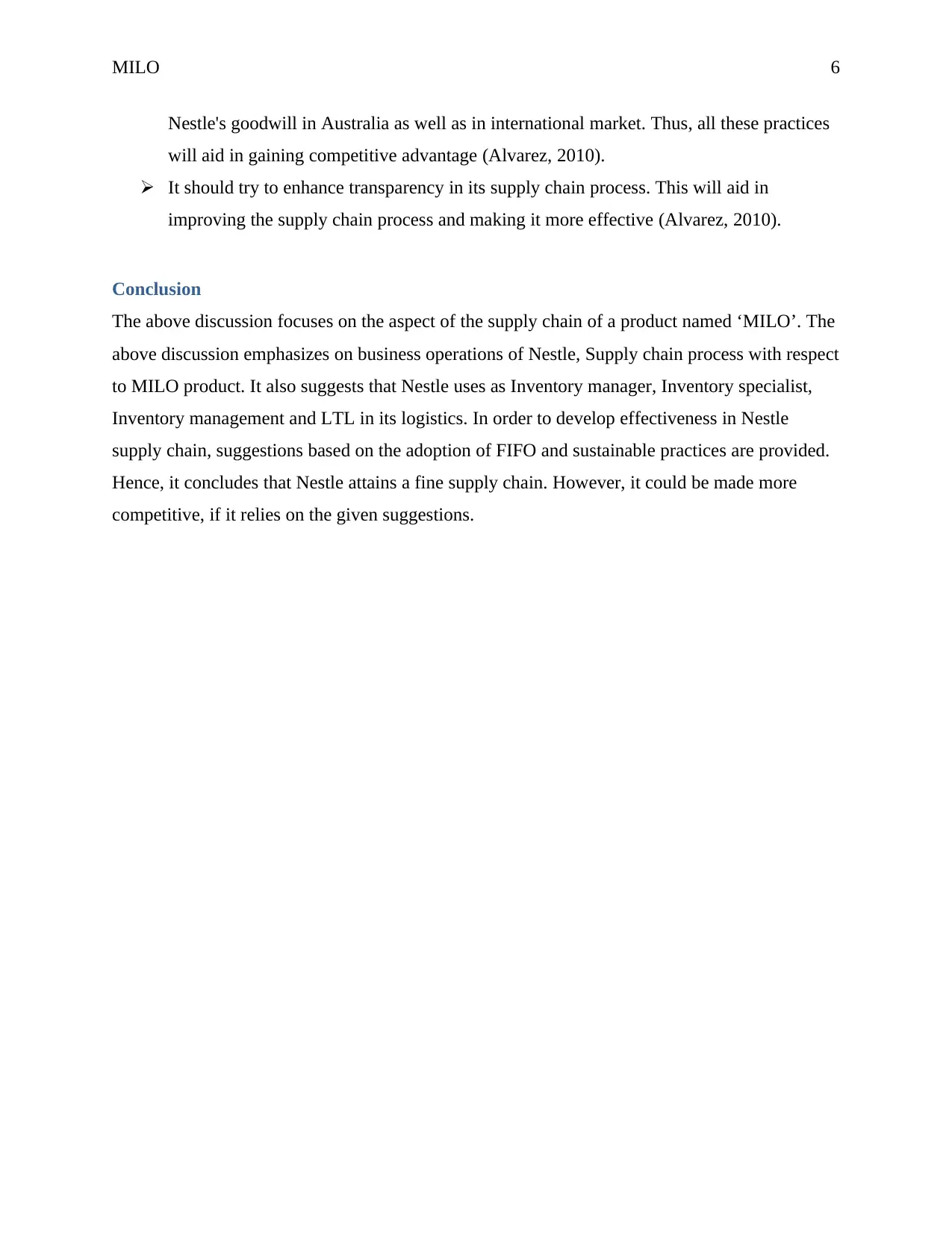
MILO 6
Nestle's goodwill in Australia as well as in international market. Thus, all these practices
will aid in gaining competitive advantage (Alvarez, 2010).
It should try to enhance transparency in its supply chain process. This will aid in
improving the supply chain process and making it more effective (Alvarez, 2010).
Conclusion
The above discussion focuses on the aspect of the supply chain of a product named ‘MILO’. The
above discussion emphasizes on business operations of Nestle, Supply chain process with respect
to MILO product. It also suggests that Nestle uses as Inventory manager, Inventory specialist,
Inventory management and LTL in its logistics. In order to develop effectiveness in Nestle
supply chain, suggestions based on the adoption of FIFO and sustainable practices are provided.
Hence, it concludes that Nestle attains a fine supply chain. However, it could be made more
competitive, if it relies on the given suggestions.
Nestle's goodwill in Australia as well as in international market. Thus, all these practices
will aid in gaining competitive advantage (Alvarez, 2010).
It should try to enhance transparency in its supply chain process. This will aid in
improving the supply chain process and making it more effective (Alvarez, 2010).
Conclusion
The above discussion focuses on the aspect of the supply chain of a product named ‘MILO’. The
above discussion emphasizes on business operations of Nestle, Supply chain process with respect
to MILO product. It also suggests that Nestle uses as Inventory manager, Inventory specialist,
Inventory management and LTL in its logistics. In order to develop effectiveness in Nestle
supply chain, suggestions based on the adoption of FIFO and sustainable practices are provided.
Hence, it concludes that Nestle attains a fine supply chain. However, it could be made more
competitive, if it relies on the given suggestions.
Paraphrase This Document
Need a fresh take? Get an instant paraphrase of this document with our AI Paraphraser
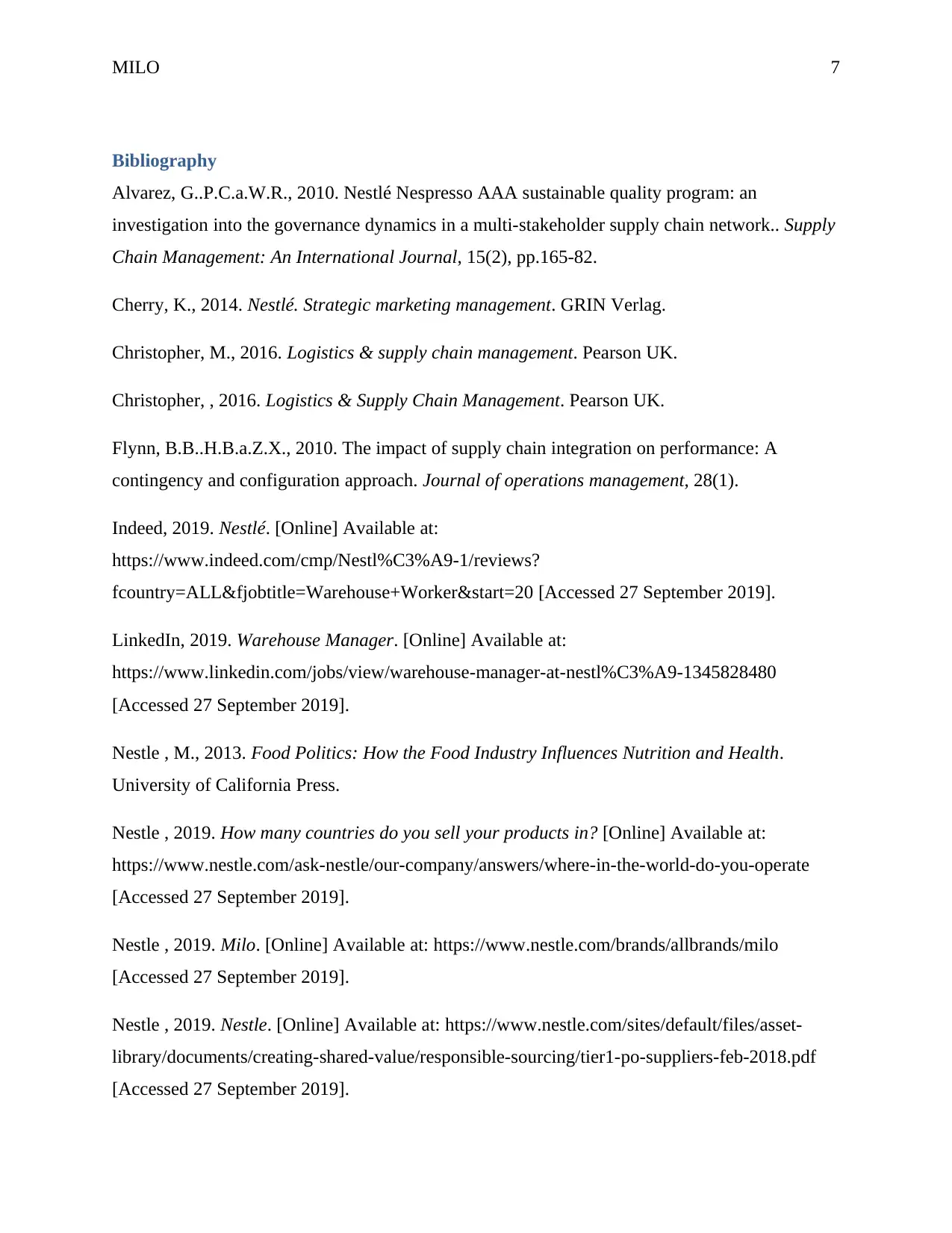
MILO 7
Bibliography
Alvarez, G..P.C.a.W.R., 2010. Nestlé Nespresso AAA sustainable quality program: an
investigation into the governance dynamics in a multi-stakeholder supply chain network.. Supply
Chain Management: An International Journal, 15(2), pp.165-82.
Cherry, K., 2014. Nestlé. Strategic marketing management. GRIN Verlag.
Christopher, M., 2016. Logistics & supply chain management. Pearson UK.
Christopher, , 2016. Logistics & Supply Chain Management. Pearson UK.
Flynn, B.B..H.B.a.Z.X., 2010. The impact of supply chain integration on performance: A
contingency and configuration approach. Journal of operations management, 28(1).
Indeed, 2019. Nestlé. [Online] Available at:
https://www.indeed.com/cmp/Nestl%C3%A9-1/reviews?
fcountry=ALL&fjobtitle=Warehouse+Worker&start=20 [Accessed 27 September 2019].
LinkedIn, 2019. Warehouse Manager. [Online] Available at:
https://www.linkedin.com/jobs/view/warehouse-manager-at-nestl%C3%A9-1345828480
[Accessed 27 September 2019].
Nestle , M., 2013. Food Politics: How the Food Industry Influences Nutrition and Health.
University of California Press.
Nestle , 2019. How many countries do you sell your products in? [Online] Available at:
https://www.nestle.com/ask-nestle/our-company/answers/where-in-the-world-do-you-operate
[Accessed 27 September 2019].
Nestle , 2019. Milo. [Online] Available at: https://www.nestle.com/brands/allbrands/milo
[Accessed 27 September 2019].
Nestle , 2019. Nestle. [Online] Available at: https://www.nestle.com/sites/default/files/asset-
library/documents/creating-shared-value/responsible-sourcing/tier1-po-suppliers-feb-2018.pdf
[Accessed 27 September 2019].
Bibliography
Alvarez, G..P.C.a.W.R., 2010. Nestlé Nespresso AAA sustainable quality program: an
investigation into the governance dynamics in a multi-stakeholder supply chain network.. Supply
Chain Management: An International Journal, 15(2), pp.165-82.
Cherry, K., 2014. Nestlé. Strategic marketing management. GRIN Verlag.
Christopher, M., 2016. Logistics & supply chain management. Pearson UK.
Christopher, , 2016. Logistics & Supply Chain Management. Pearson UK.
Flynn, B.B..H.B.a.Z.X., 2010. The impact of supply chain integration on performance: A
contingency and configuration approach. Journal of operations management, 28(1).
Indeed, 2019. Nestlé. [Online] Available at:
https://www.indeed.com/cmp/Nestl%C3%A9-1/reviews?
fcountry=ALL&fjobtitle=Warehouse+Worker&start=20 [Accessed 27 September 2019].
LinkedIn, 2019. Warehouse Manager. [Online] Available at:
https://www.linkedin.com/jobs/view/warehouse-manager-at-nestl%C3%A9-1345828480
[Accessed 27 September 2019].
Nestle , M., 2013. Food Politics: How the Food Industry Influences Nutrition and Health.
University of California Press.
Nestle , 2019. How many countries do you sell your products in? [Online] Available at:
https://www.nestle.com/ask-nestle/our-company/answers/where-in-the-world-do-you-operate
[Accessed 27 September 2019].
Nestle , 2019. Milo. [Online] Available at: https://www.nestle.com/brands/allbrands/milo
[Accessed 27 September 2019].
Nestle , 2019. Nestle. [Online] Available at: https://www.nestle.com/sites/default/files/asset-
library/documents/creating-shared-value/responsible-sourcing/tier1-po-suppliers-feb-2018.pdf
[Accessed 27 September 2019].
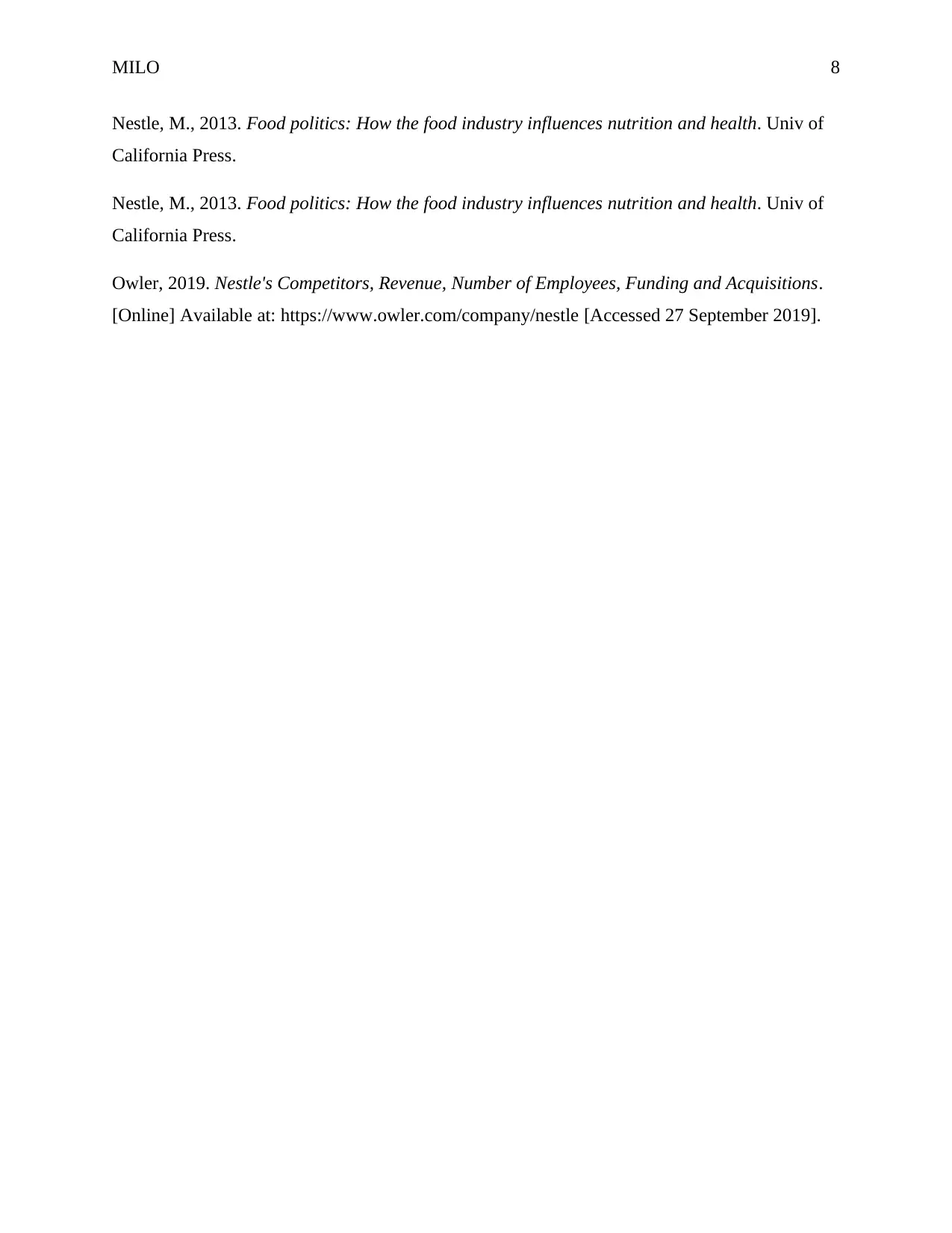
MILO 8
Nestle, M., 2013. Food politics: How the food industry influences nutrition and health. Univ of
California Press.
Nestle, M., 2013. Food politics: How the food industry influences nutrition and health. Univ of
California Press.
Owler, 2019. Nestle's Competitors, Revenue, Number of Employees, Funding and Acquisitions.
[Online] Available at: https://www.owler.com/company/nestle [Accessed 27 September 2019].
Nestle, M., 2013. Food politics: How the food industry influences nutrition and health. Univ of
California Press.
Nestle, M., 2013. Food politics: How the food industry influences nutrition and health. Univ of
California Press.
Owler, 2019. Nestle's Competitors, Revenue, Number of Employees, Funding and Acquisitions.
[Online] Available at: https://www.owler.com/company/nestle [Accessed 27 September 2019].
⊘ This is a preview!⊘
Do you want full access?
Subscribe today to unlock all pages.

Trusted by 1+ million students worldwide
1 out of 9
Related Documents
Your All-in-One AI-Powered Toolkit for Academic Success.
+13062052269
info@desklib.com
Available 24*7 on WhatsApp / Email
![[object Object]](/_next/static/media/star-bottom.7253800d.svg)
Unlock your academic potential
Copyright © 2020–2025 A2Z Services. All Rights Reserved. Developed and managed by ZUCOL.





